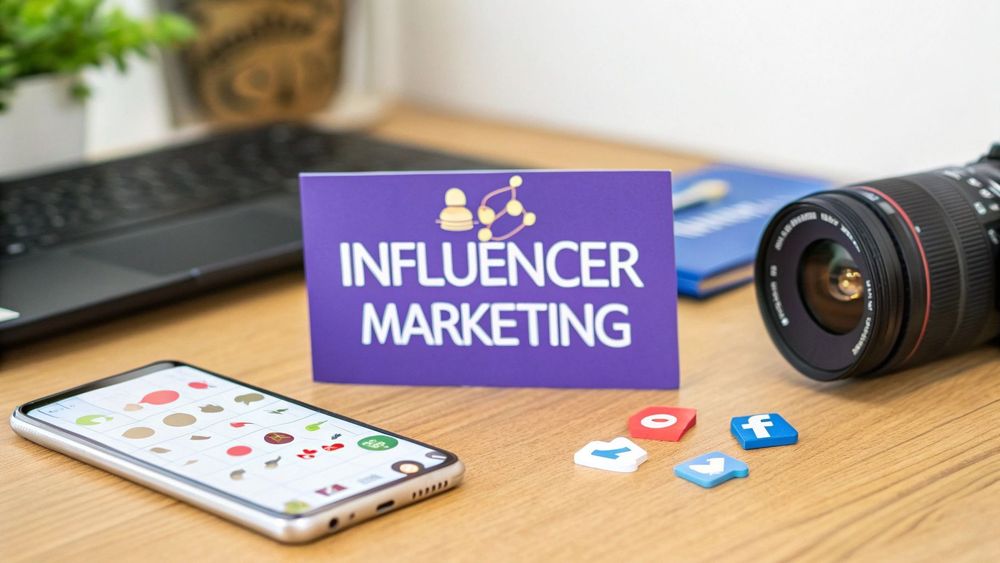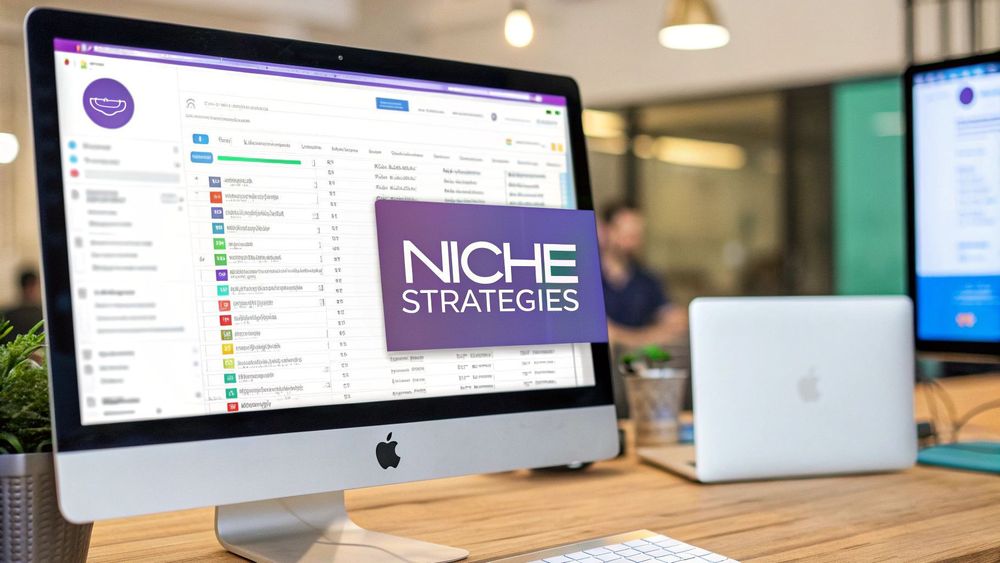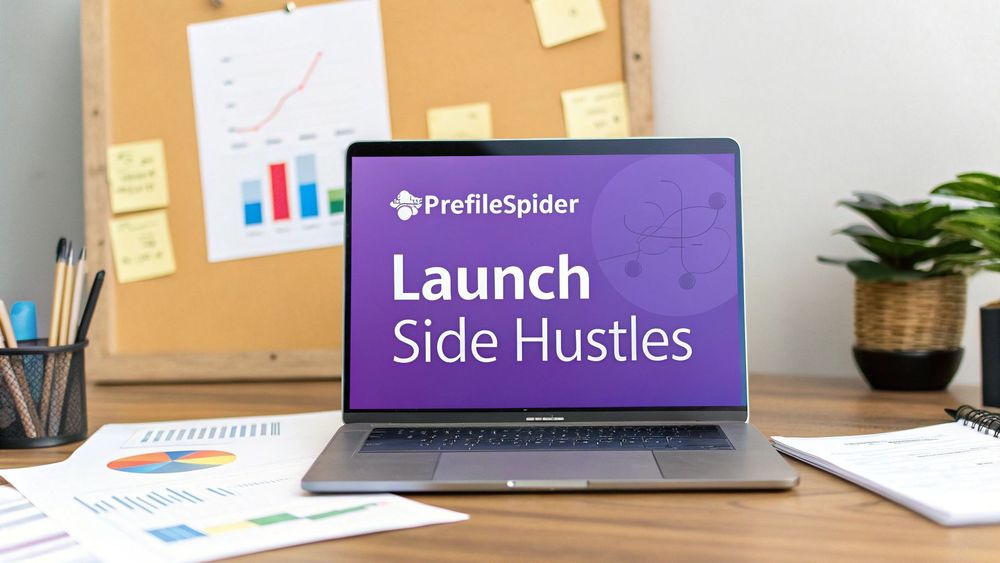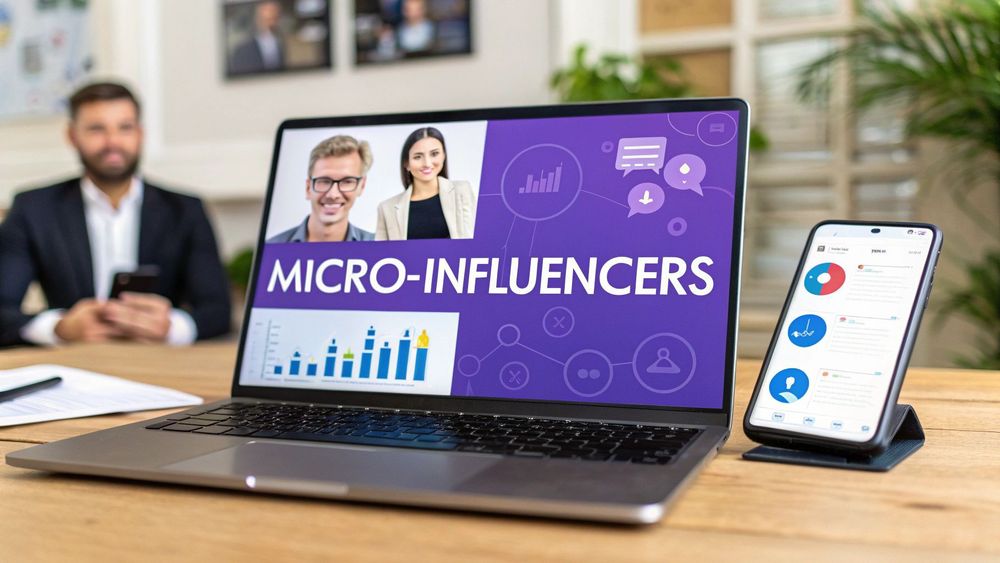Influencer marketing is a powerful way for brands to connect with potential customers. It works by partnering with people who have built a dedicated online following to talk about products or services. This strategy leverages the trust and credibility these creators have with their audience, cutting through the noise of traditional advertising with a more authentic, word-of-mouth approach.
So, What Exactly Is Influencer Marketing?
At its core, influencer marketing is a form of social proof where brands collaborate with credible, niche content creators to build trust and drive action. Instead of a brand promoting itself, it taps into the genuine relationship an influencer already has with their followers. This feels more organic than a typical ad, which is why it's so effective.
The entire strategy depends on finding the right partners—individuals whose audience and values align with the brand. It’s not just about follower count; it’s about engagement, authenticity, and a creator’s ability to produce content that connects. For a deeper look into understanding what influencer marketing truly is, this guide will cover the essentials.
The Move From Big-Name Celebs to Niche Experts
Years ago, endorsements were reserved for A-list celebrities. Today, the focus has shifted to a diverse world of creators who hold real authority within specific communities. This includes everyone from global superstars to "nano-influencers" with smaller, highly engaged followings.
- Mega-Influencers: Household names with over a million followers, offering massive reach for brand awareness campaigns.
- Macro-Influencers: Professional content creators with 100,000 to 1 million followers who have significant influence in their niche.
- Micro-Influencers: With 10,000 to 100,000 followers, these creators are known for high engagement rates and strong community bonds.
- Nano-Influencers: Creators with fewer than 10,000 followers whose recommendations feel like they're coming from a trusted friend, making them powerful brand advocates.
Each tier offers unique advantages depending on your campaign goals.
Understanding Influencer Tiers and Their Strengths
| Influencer Tier | Follower Range | Primary Strength |
|---|---|---|
| Mega-Influencers | 1M+ | Unmatched reach and mass awareness |
| Macro-Influencers | 100K - 1M | High-impact content and broad niche authority |
| Micro-Influencers | 10K - 100K | Exceptional engagement and community trust |
| Nano-Influencers | < 10K | Hyper-authentic connections and high conversion |
This tiered approach shows there’s no one-size-fits-all solution. The best strategy often involves a mix of influencer types to achieve various campaign goals, from broad awareness to specific actions.
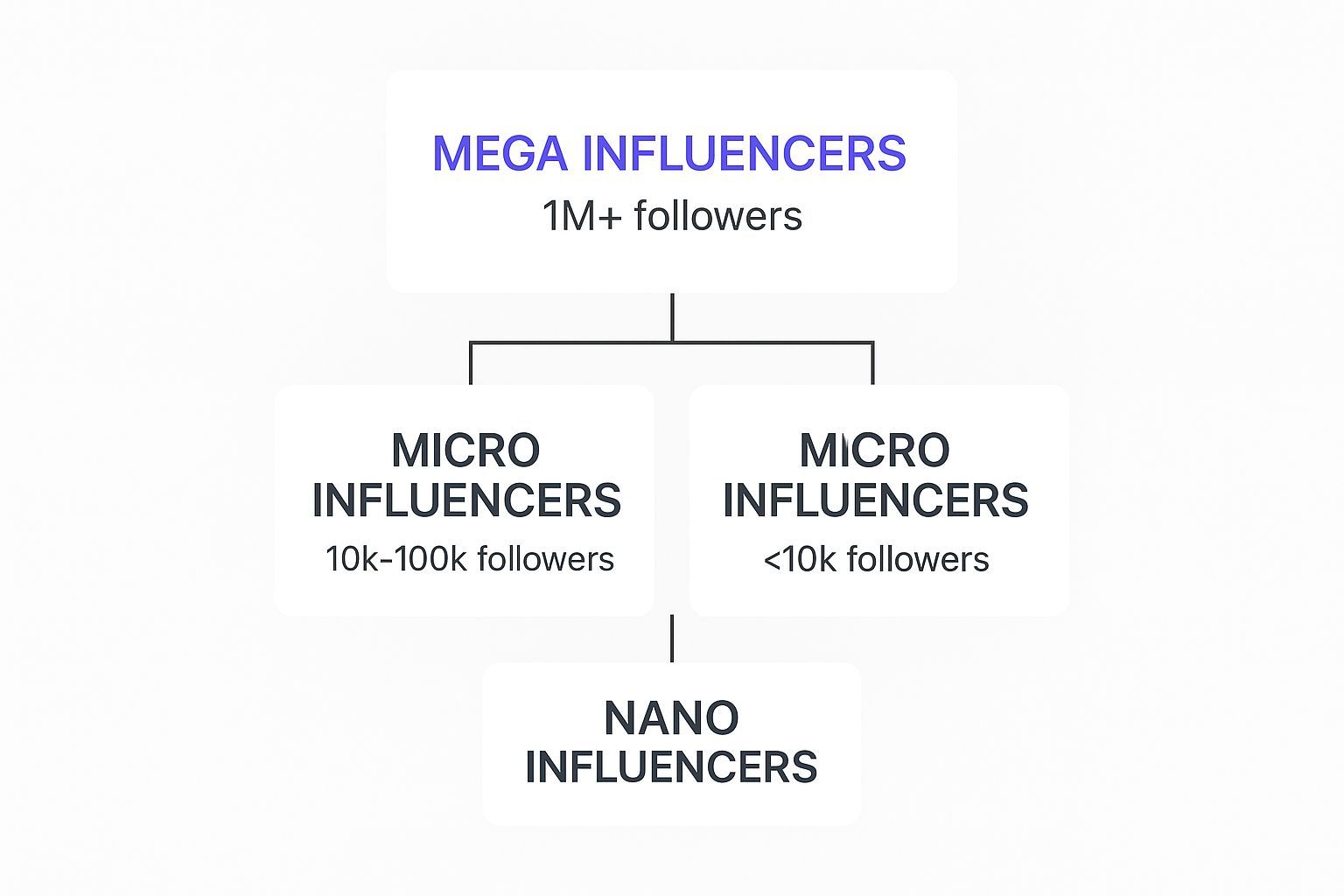
This visual breaks down how different influencer tiers are defined by audience size, reinforcing that a successful strategy can be built with partners of any scale.
Why It’s Now a Core Part of Any Modern Strategy
Brands are investing heavily in influencer marketing because it delivers results. The industry is projected to become a $32.55 billion global market by 2025, a significant jump from its nearly $10 billion valuation in 2020. This growth is supported by its effectiveness, with over 80% of marketers reporting a strong return on investment. It's no longer a fringe tactic but a central pillar of modern digital marketing.
The real value of influencer marketing is its ability to borrow trust. When a creator someone follows and respects recommends a product, that endorsement carries more weight than any traditional advertisement.
The primary challenge is finding and managing the right creators. This foundational step determines a campaign's success. For marketers looking to build a roster of partners, modern tools are essential.
Choosing Your Influencer Campaign Strategy
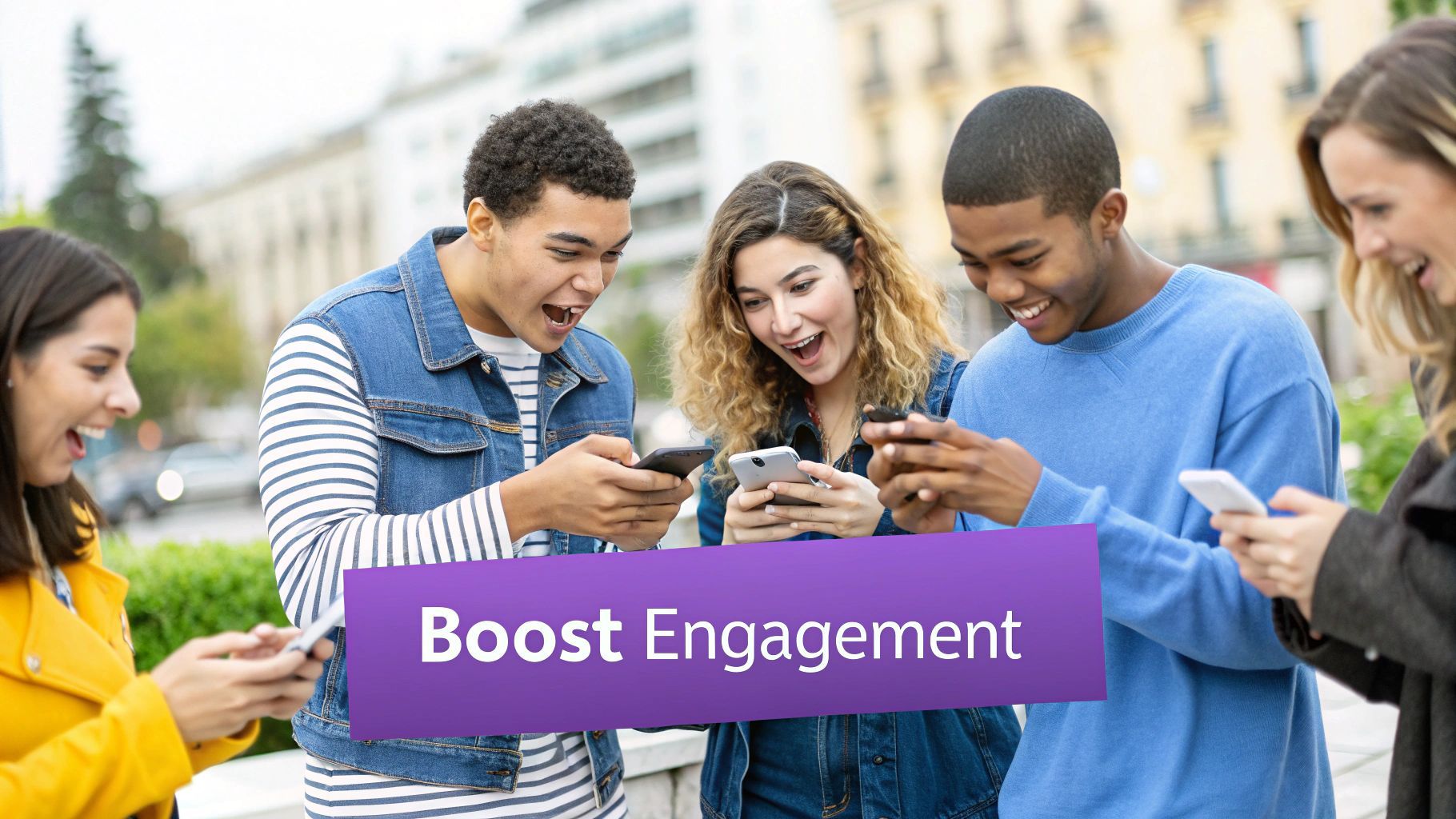
Once you understand the power of influencer marketing, the next step is deciding what kind of campaign to run. The best approach depends entirely on your business goals. Choosing the right strategy is the difference between a message that resonates and one that falls flat. A campaign for a product launch requires a different approach than a long-term initiative to build brand loyalty.
Common Influencer Collaboration Models
Each campaign type serves a unique purpose, from generating a quick burst of excitement to building lasting customer relationships. Understanding these options is the first step toward crafting a successful plan.
Here are some of the most popular and effective strategies:
Sponsored Content: The most direct model, where you pay an influencer to create and share content featuring your product. This is excellent for raising brand awareness and highlighting specific products, especially on platforms like Instagram and TikTok.
Product Gifting: Instead of payment, you send your product to influencers for free. This is a great way to generate authentic reviews and user-generated content, as 69% of consumers trust recommendations from influencers more than from brands.
Affiliate Partnerships: A performance-based model where influencers earn a commission on sales driven through a unique link or discount code. This directly ties their efforts to your bottom line, making it ideal for driving conversions.
These are foundational strategies, but for a greater impact, you need to think beyond one-off collaborations.
Advanced Strategies for Deeper Engagement
To integrate your brand into an influencer's world, you need to build more meaningful partnerships. These advanced strategies focus on creating a more organic and sustained presence.
A successful influencer marketing campaign isn't just a transaction; it's a strategic partnership. The goal is to move beyond a single post and build a collaborative relationship that benefits both your brand and the creator's audience.
Here are two powerful long-term options:
Brand Ambassador Programs: This involves forming a long-term relationship with an influencer who genuinely loves your brand. They become a consistent advocate, regularly featuring your products. This strategy is unmatched for building deep-seated trust and loyalty over time.
Social Media Takeovers: For a boost in engagement, let an influencer "take over" your social media accounts for a day. They create content directly on your profiles, providing a fresh voice and introducing their followers to your brand in a dynamic way.
Ultimately, choosing the right strategy means matching the collaboration model to your objective. Whether you need a quick spike in visibility or want to build lasting credibility, your goal will determine the best path forward.
How to Find the Right Influencers for Your Brand
Finding the perfect influencer is the most critical and challenging part of any campaign. It determines whether your message connects with the right audience or gets lost in the digital noise. The traditional, manual method of discovery can be incredibly time-consuming.
The old-school approach involves hours of repetitive work: scrolling through hashtags, manually sifting through competitors' follower lists, and vetting profiles one by one. This process is not only slow but also often results in incomplete data and missed opportunities.
The Pitfalls of Manual Influencer Discovery
Building an influencer list manually is a significant drain on resources. The process typically involves spreadsheets and a great deal of patience, leading to common frustrations:
- Incomplete Data: You find a great profile on Instagram but can't locate their email or blog for outreach. Piecing together a complete contact profile is a tedious task.
- Wasted Time: The hours spent on manual data entry could be better used for strategy and relationship-building.
- Lack of Scalability: Finding five influencers manually is manageable, but finding fifty for a larger campaign quickly becomes an administrative nightmare that disrupts your marketing timeline.
These challenges create a major bottleneck. To stay competitive, marketers need a faster, more accurate way to build targeted influencer lists.
The Modern Way: One-Click Influencer Discovery
This is where a modern, no-code solution like ProfileSpider changes the game. It automates the entire discovery and data collection process, turning a multi-day research project into a task that takes just minutes.
Imagine you're a marketer for a sustainable fashion brand and find a blog post listing the "Top 20 Eco-Friendly Fashion Bloggers." The traditional method would involve opening twenty tabs, hunting for contact information, and manually entering it into a spreadsheet. With ProfileSpider, you simply navigate to the list, open the extension, and extract all twenty profiles with a single click. The AI-powered engine instantly captures names, social media links, websites, and contact information, delivering a structured list ready for export.
By automating manual data collection, you can shift your focus from research to what truly matters: building the genuine partnerships that drive results.
Build Your Influencer Database in a Click
ProfileSpider works on any website, not just major social media platforms. You can extract influencer profiles from blogs, online magazines, and niche forums, helping you discover creators your competitors might miss.
The influencer world is vast, with an estimated 50 million influencers globally. Micro-influencers (with 5,000 to 20,000 followers) are particularly effective, boasting an average engagement rate of 3.86%, often higher than their mega-influencer counterparts. For brands looking to tap into these engaged communities, it's helpful to review specific tips on how to find micro-influencers.
With a tool like ProfileSpider, you can build a comprehensive and accurate influencer database faster than ever. All data is stored locally in your browser, ensuring you maintain complete privacy and control over your lists. This automated process sets a solid foundation for your next successful campaign.
Building an Effective Influencer Outreach Strategy
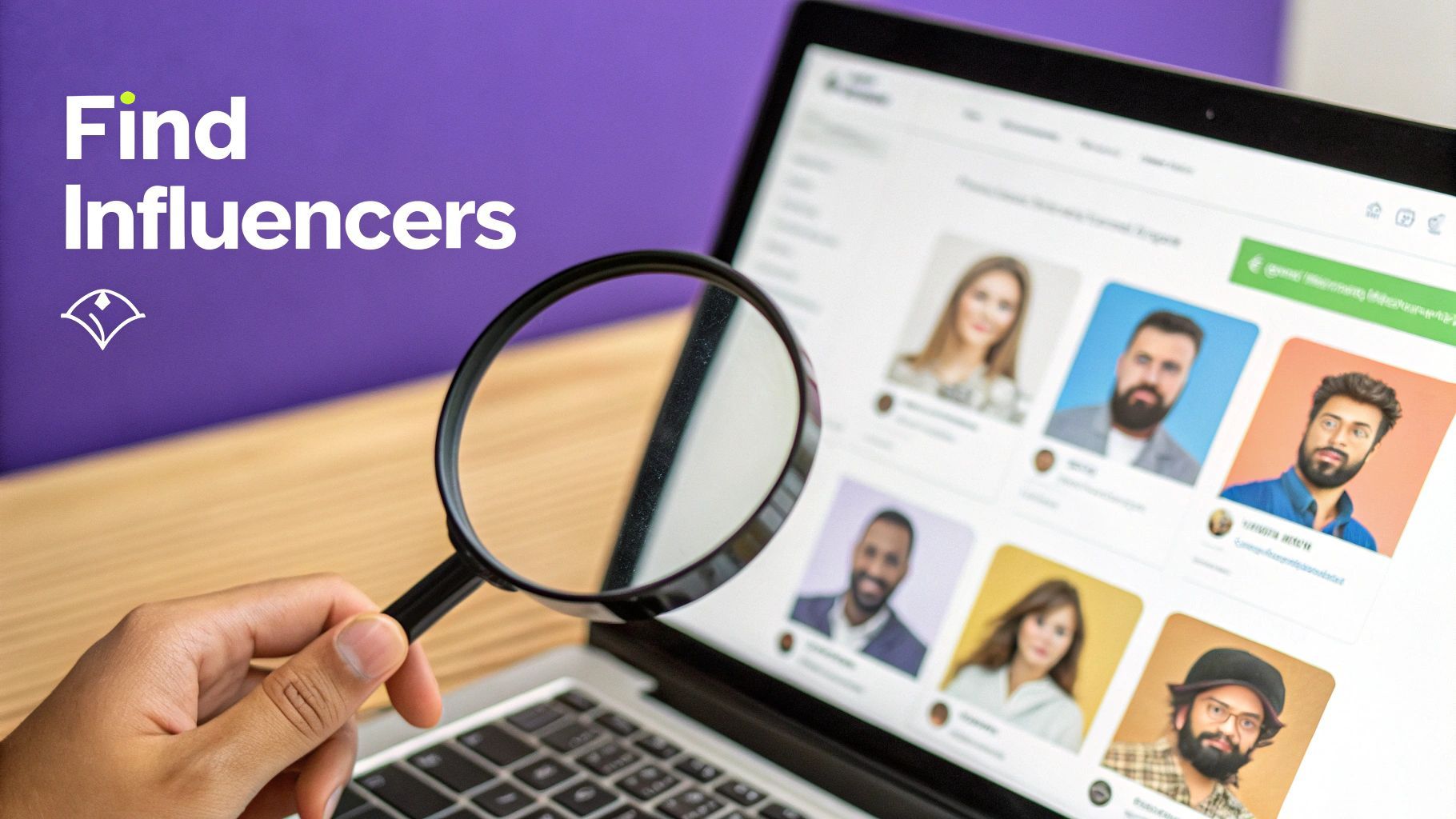
You've identified your ideal influencers. Now comes the crucial step: reaching out with a message that stands out. Effective outreach requires a blend of professionalism, personalization, and a clear value proposition. Top creators receive dozens of pitches daily, so a generic message is a fast track to being ignored. Your first message should demonstrate that you've done your research and genuinely believe a partnership would be mutually beneficial.
Crafting Outreach That Gets a Response
A strong outreach message is direct, respectful, and focused on mutual value. Remember, influencers are running businesses. Your pitch should feel like a professional proposal.
Here’s what a persuasive outreach message should include:
- A Clear Subject Line: Keep it concise and professional. Something like “Collaboration Idea: [Your Brand] x [Influencer's Name]” works well.
- A Personalized Opening: Start by referencing their specific work. For example, "I loved your recent video on sustainable living—your tips on reducing waste were fantastic." This shows you're not just sending a mass email.
- A Clear Value Proposition: Quickly explain who you are, what you're proposing, and what's in it for them. Be upfront about compensation, whether it's a paid collaboration, free product, or an affiliate partnership.
- A Simple Call to Action: End with a clear next step, like "Are you open to discussing a potential partnership?"
Negotiating Terms and Finalizing Agreements
Once an influencer expresses interest, the conversation moves to negotiation. This is where you finalize details like compensation, deliverables, usage rights, and timelines. Clear expectations are key to a fair and successful partnership.
Negotiation is a collaborative process, not a confrontation. A successful influencer marketing partnership is built on mutual respect and a clear understanding of the value each party brings to the table.
Always get the final agreement in writing. A solid contract should detail payment schedules, content approval processes, and FTC disclosure requirements. This document protects both you and the creator.
Managing Your Outreach Pipeline with ProfileSpider
As you scale your outreach, tracking conversations can become chaotic. This is where a streamlined workflow is essential. Instead of juggling spreadsheets and notes, you can use ProfileSpider to build and manage your entire outreach pipeline. Organize the influencers you've extracted into custom lists that mirror your outreach stages, ensuring no opportunity is lost.
For example, you can create lists to track each stage of the process.

This shows how easy it is to create distinct lists to manage your pipeline, moving contacts from discovery to active campaigns.
By creating lists like 'Initial Outreach,' 'In Negotiation,' and 'Campaign Live,' you get a clean overview of your influencer marketing funnel. Add custom tags to segment influencers by niche ('Beauty,' 'Tech') or status for easy sorting. This organized approach, common in effective marketing automation workflow examples, keeps your data private and stored locally.
Measuring Your Influencer Marketing Success
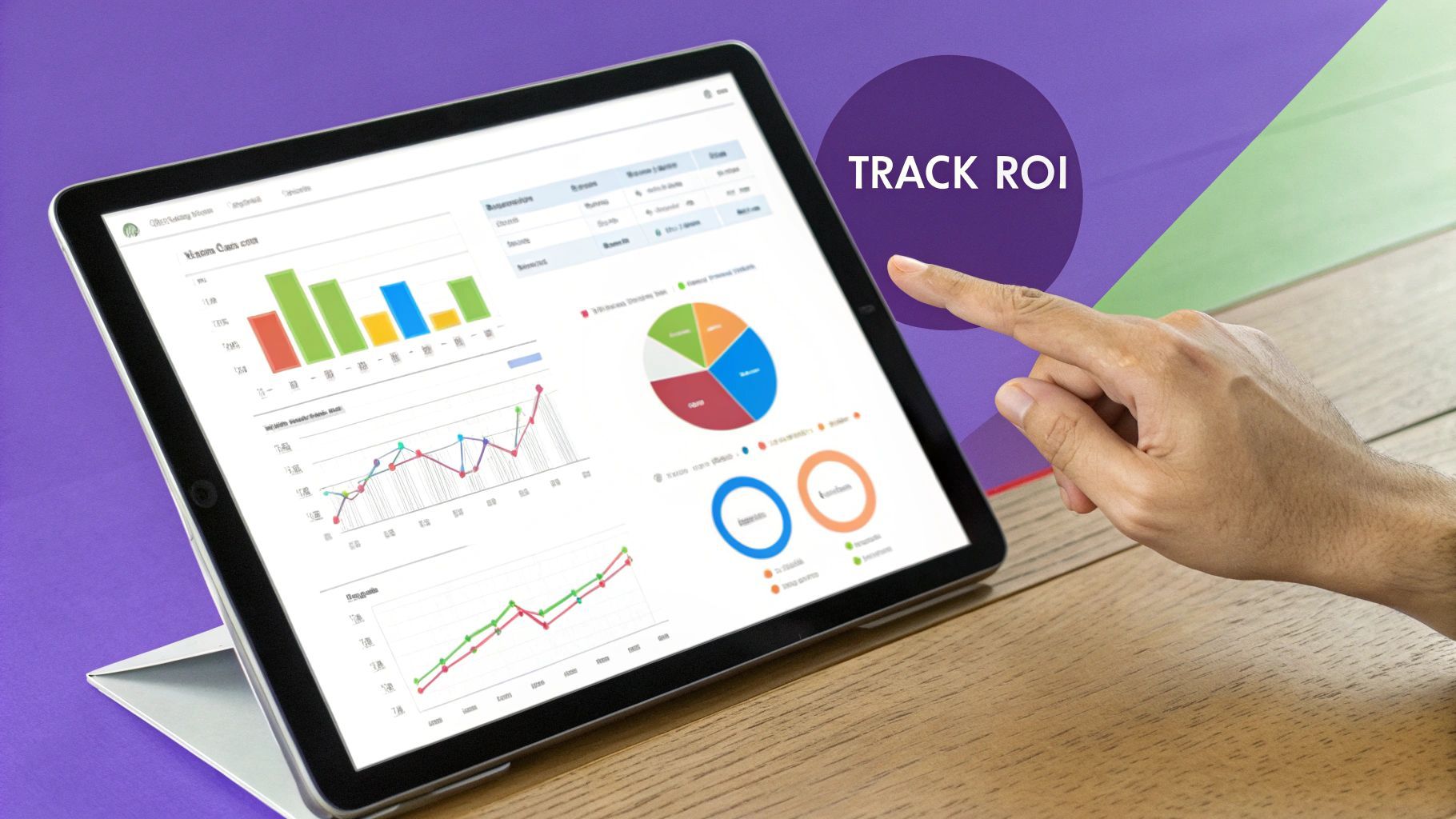
Running an influencer marketing campaign without clear metrics is like driving blind. To prove your efforts are effective, you must look beyond vanity metrics like likes and follower counts and focus on key performance indicators (KPIs) that align with your business goals. Tracking the right data not only demonstrates the value of your campaigns but also provides insights to refine future strategies.
Key Metrics That Actually Matter
To measure success, focus on data that reflects audience behavior and its impact on your bottom line.
Engagement Rate: This is the best indicator of how an influencer's audience interacts with their content. Calculate it by adding up likes, comments, and shares, then dividing by the follower count. A high engagement rate means the audience is active and attentive.
Click-Through Rate (CTR): This measures how many people clicked a specific link in an influencer's post. It's a direct measure of how effectively an influencer is driving traffic to your website.
Conversion Rate: This tracks the percentage of users who completed a desired action after clicking an influencer's link, such as making a purchase, signing up for a newsletter, or downloading an app.
Cost Per Acquisition (CPA): This KPI calculates how much it cost to acquire a new customer through the campaign, providing a clear understanding of the financial return on your investment.
Tracking these core metrics helps you shift the conversation from "how many people saw it?" to "how many people took action?" This is the key to proving real, measurable ROI.
Tools for Tracking Your ROI
The best way to track performance is by providing each influencer with unique assets you can monitor.
UTM Parameters are snippets of code added to a URL that allow you to track clicks and conversions in platforms like Google Analytics. By creating unique UTM links for each influencer, you can see exactly how much traffic and revenue their posts generate.
Unique Discount Codes are another excellent way to attribute sales. Give each influencer a custom code (e.g., "INFLUENCER15") to easily track every purchase made with it.
This focus on measurable results is why a detailed report on influencer marketing shows that by 2025, 80% of brands plan to maintain or increase their influencer marketing budgets. Furthermore, 73% of brands report that AI has improved their marketing by helping automate and personalize campaigns for better performance.
Streamlining Data for Analysis with ProfileSpider
As you scale your influencer program, managing data from multiple collaborations can become complex. ProfileSpider simplifies this by allowing you to export your organized influencer lists into a CSV file. You can then upload this file into your CRM or analytics platform, linking your outreach efforts directly to performance data. This one-click export bridges the gap between finding influencers and analyzing ROI, giving you a centralized dataset to make smarter, data-driven decisions.
Common Questions About Influencer Marketing
As you plan your influencer campaigns, a few common questions often arise. This world moves quickly, and the rules aren't always clear. Let's address some of the most frequent questions to help you build your strategy with confidence.
How Much Should I Pay an Influencer?
The answer is: it depends. There is no universal rate card. Compensation depends on several factors:
- Follower Count: A mega-influencer with millions of followers will command a higher fee than a creator with a few thousand.
- Engagement Rate: This is often more important than follower count. A smaller, highly engaged audience is incredibly valuable.
- Type of Content: A simple Instagram Story costs less than a professionally produced 10-minute YouTube review.
- The Niche: Influencers in high-demand niches like tech or finance can often charge more than those in saturated markets like fashion.
Think of it less like buying an ad and more like commissioning a creative project. Start with industry benchmarks, but be prepared to negotiate. The best partnerships are built on a fair value exchange.
Do We Really Need to Disclose a Paid Partnership?
Yes, absolutely. Transparency is a legal requirement. In the U.S., the Federal Trade Commission (FTC) has clear rules that paid partnerships must be disclosed. The audience deserves to know when content is a paid advertisement. This typically means using a clear hashtag like #ad or #sponsored at the beginning of the caption. Non-compliance can result in significant fines for both your brand and the influencer.
What’s the Best Platform for Influencer Marketing?
The "best" platform is wherever your target audience spends their time. Don't just follow trends; go where your customers are.
Here’s a quick breakdown of the major platforms:
- Instagram: The top choice for visual brands in fashion, beauty, food, and travel. It offers creative flexibility with Stories, Reels, and static posts.
- TikTok: Essential for reaching Gen Z and younger millennials. It's the hub of internet culture, perfect for driving trends with short-form video.
- YouTube: Ideal for long-form content like detailed tutorials and product reviews that build trust and authority.
- LinkedIn: The undisputed leader for B2B influencer marketing. It's the place to connect with industry experts and thought leaders to build credibility.
Each platform has its own culture. A successful strategy adapts to feel native to the channel, ensuring collaborations feel authentic to that specific audience.

